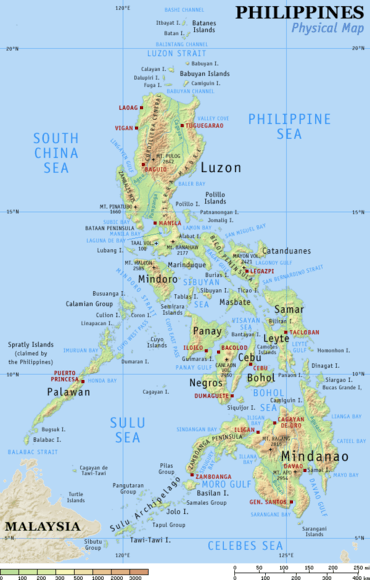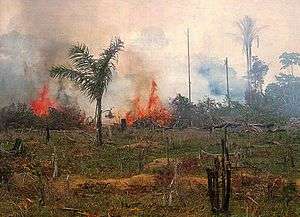Deforestation in the Philippines
Along with other Southeast Asian countries deforestation in the Philippines is a major environmental issue.

Rate of deforestation
Over the course of the 20th century the forest cover of the Philippines dropped from 70 percent down to 20 percent.[1]
In total, 46 species are endangered, and 4 were already eradicated completely. Only 3.2 percent of total rainforest has been left.
Based on an analysis of land use pattern maps and a road map an estimated 9.8 million hectares of forests were lost in the Philippines from 1934 to 1988.[2]
Causes
According to scholar Jessica Mathews, short-sighted policies by the Filipino government have contributed to the high rate of deforestation:
The government regularly granted logging concessions of less than ten years. Since it takes 30–35 years for a second-growth forest to mature, loggers had no incentive to replant. Compounding the error, flat royalties encouraged the loggers to remove only the most valuable species. A horrendous 40 percent of the harvestable lumber never left the forests but, having been damaged in the logging, rotted or was burned in place. The unsurprising result of these and related policies is that out of 17 million hectares of closed forests that flourished early in the century only 1.2 million remain today.[3]
Illegal logging
Illegal logging occurs in the Philippines [4] and intensifies flood damage in some areas.[5]
Conservation efforts
Government policies
On June 1977, President Ferdinand Marcos signed a law requiring the planting of one tree every month for five consecutive years by every citizen of the Philippines.[6] The law, however, was repealed by President Corazon Aquino on July 1987,[7] with the sole reason that the planting of trees "can be achieved without the compulsion and the penalties for non-compliance therewith as set forth in the Decree".[8]
On September 2012, President Benigno Aquino III signed a law requiring all able-bodied citizens of the Philippines, who are at least 12 years of age, to plant one tree every year.[9] Unfortunately, unlike Presidential Decree 1153, there is no provision in the law to enforce and monitor compliance to this requirement.[7]
On May 2019, the House of Representatives of the Philippines has approved House Bill 8728, or the "Graduation Legacy for the Environment Act," principally authored by Magdalo Party-List Representative Gary Alejano and Cavite 2nd District Representative Strike Revilla, requiring all graduating elementary, high school, and college students to plant at least 10 trees each before they can graduate.[10] The bill, however, has yet to be signed by the President.[7]
See also
- Environmental issues in the Philippines
- Luzon rainforest
References
- Lasco, R. D.; R. D. (2001). "Secondary forests in the Philippines: formation and transformation in the 20th century" (PDF). Journal of Tropical Forest Science. 13 (4): 652–670.
- Liu, D; L Iverson; S Brown (1993). "Rates and patterns of deforestation in the Philippines: application of geographic information system analysis" (PDF). Forest Ecology and Management. 57 (1–4): 1–16. doi:10.1016/0378-1127(93)90158-J. ISSN 0378-1127.
- Mathews, Jessica Tuchman (1989). "Redefining Security" (PDF). Foreign Affairs. 68 (2).
- Teehankee, Julio C. (1993). "The State, Illegal Logging, and Environmental NGOs, in the Philippines". Kasarinlan: Philippine Journal of Third World Studies. 9 (1). ISSN 2012-080X.
- "Illegal logging a major factor in flood devastation of Philippines". Terra Daily (AFP). 1 December 2004. Retrieved 13 February 2011.
- "Presidential Decree No. 1153, s. 1977". Official Gazette of the Republic of the Philippines. Archived from the original on 23 September 2017. Retrieved 24 December 2019.
- Pena, Rox (29 August 2019). "Peña: Tree planting requirement for graduation". Sunstar. Archived from the original on 29 August 2019. Retrieved 24 December 2019.
- "Executive Order No. 287, s. 1987". Official Gazette of the Republic of the Philippines. Archived from the original on 16 September 2017. Retrieved 24 December 2019.
- "Republic Act No. 10176". Official Gazette of the Republic of the Philippines. Archived from the original on 17 April 2018. Retrieved 24 December 2019.
- "House passes bill requiring graduating students to plant 10 trees on final reading". CNN Philippines. 16 May 2019. Archived from the original on 15 May 2019. Retrieved 24 December 2019.
Further reading
- Cavanagh, John; Broad, Robin (1994). Plundering Paradise: The Struggle for the Environment in the Philippines. Berkeley: University of California Press. ISBN 0-520-08921-9.
External links
- Philippines Forests at Mongabay
- Illegal logging in the Phililpines
- The Lost Forest at Fieldmuseum.org
